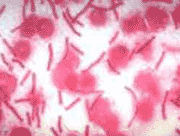透视炭疽热
 Anthrax bacterium under the microscope
Anthrax bacterium under the microscope
What is anthrax?
Anthrax is a colorless, odorless, tasteless bacterium that protects itself from sunlight, heat and disinfectant by forming a protective coat. With this coat, the bacterium is called a "spore." The spores are so small that even an infectious dose - between 8,000 and 10,000 spores - is smaller than a speck of dust.
If inhaled, anthrax spores can germinate and lead to infection within one to 60 days. This is pulmonary anthrax, which usually causes death.
Less lethal forms include cutaneous infections, which occur if anthrax spores come in contact with a cut or other opening in the skin.
Another form of anthrax develops in the intestine of those who eat improperly cooked meat of animals that have been infected with anthrax.
Is anthrax contagious?
Anthrax does not spread from person to person. It is a "one-time agent" - to catch it a person must come directly in contact with the bacterium.
What are the symptoms of anthrax?
Symptoms of pulmonary anthrax are very similar to the flu, which can make an initial diagnosis somewhat difficult. However, in light of recent events many doctors have a heightened awareness of the possibility, and are therefore more likely to diagnose it.
Symptoms of the disease vary depending on how the disease was contracted, but usually occur within seven days. The Centers for Disease Control list the following:
Cutaneous: Most (about 95 percent) anthrax infections occur when the bacterium enters a cut or abrasion on the skin, such as when handling contaminated wool, hides, leather or hair products (especially goat hair) of infected animals. Skin infection begins as a raised itchy bump that is dark in color and resembles an insect bite but within 1-2 days develops into a vesicle and then a painless ulcer, usually 1-3 centimeters in diameter, with a characteristic black area in the center. Lymph glands in the adjacent area may swell. About 20 percent of untreated cases of cutaneous anthrax will result in death. Deaths are rare with appropriate therapy.
Inhalation: Initial symptoms may resemble a common cold. After several days, the symptoms may progress to severe breathing problems and shock. Inhalation anthrax is usually fatal.
Intestinal: The intestinal disease form of anthrax may follow the consumption of contaminated meat and is characterized by an acute inflammation of the intestinal tract. Initial signs of nausea, loss of appetite, vomiting, fever are followed by abdominal pain, vomiting of blood, and severe diarrhea. Intestinal anthrax results in death in 25 percent to 60 percent of cases.
What is the treatment for anthrax?
Antibiotics, including Ciprofloxacin (sometimes shortened to "cipro") and penicillin can be effective if administered after infection. For pulmonary anthrax, the drugs must be administered very soon after infection.
什么是炭疽热?
炭疽热是一种无色、无味的细菌。炭疽热杆菌会形成孢子结构,其孢囊可以保护细菌本身不受光、热和杀毒剂的影响。炭疽热的孢子体积非常小,通常8000 至10000个孢子达到感染浓度,这么多数量的孢子体积要比一粒灰尘的体积还要小。
如果吸入炭疽热细菌,其孢子会在生物体内迅速增生,生物体将在1天至60天内被感染。这种呼吸性炭疽热细菌的感染通常是致命的。
另一种炭疽热是皮肤性炭疽热。这种炭疽热是由于炭疽热孢子通过伤口裸露的皮肤进入感染对象体内,它通常没有生命危险。
最后一种炭疽热是肠胃性炭疽热。食用感染了炭疽热杆菌,且没有煮熟的肉类是此类炭疽热的主要传播渠道。
炭疽热会传染吗?
人和人之间并不会互相传染炭疽热。炭疽热必须是人们直接接触了这种病菌,才有可能被感染。
炭疽热的症状
肺部炭疽热的症状与流感很相似,所以由初期症状很难确诊。但是许多医生认为最近出现的几例病例在症状上很有可能就是炭疽热。
由于传染方式的不同,炭疽热也呈现各种不同的症状,但是通常炭疽病菌的潜伏期为7天。以下是疾病控制中心列出的各种炭疽热的症状:
皮肤性炭疽热:大约95%的炭疽热患者是通过皮肤接触感染病菌的,炭疽热杆菌通过被切开或磨损的皮肤进入生物体内。感染初期生物体将出现有痒感的肿块,痒的程度要超过一般的蚊虫叮咬,随后将发展成1-3厘米的无痛感皮肤溃疡,溃疡的中央将形成炭疽热感染所特有的黑色腐肉。
炭疽热杆菌会通过坏死的皮肤和肌肉组织渗入血液循环系统,患者将出现浑身乏力,出虚汗、发烧、打冷颤、苍白、头痛、虚脱等症状,严重时还会出现休克。如果不采取及时的治疗措施,皮肤性炭疽热还是会导致死亡,死亡率为20%。
·呼吸性炭疽热:炭疽热杆菌通过空气传播,进入生物的呼吸系统和肺部,再进入血液循环。患者会很快出现感冒或肺炎的症状,呼吸困难,有时还会伴随脑膜炎的发生。
这种类型的炭疽热感染概率非常低,但后果最为严重,患者可能会在不到48小时内丧生。其临床症状主要有发烧、全身不适、头痛、呼吸急促、咳嗽、鼻喉充血以及关节僵硬疼痛等。
·肠道性炭疽热:食用感染了炭疽热杆菌,且没有煮熟的肉类是此类炭疽热的主要传播渠道。
肠道性炭疽热因其感染部位的不同又可分为口腔-咽喉型和腹部型。前者属于上消化系统感染,患者的口腔和食道会出现溃疡,然后出现局部淋巴结肿大、败血症等症状。患者会感觉呼吸、吞咽困难。
而后者则是下消化系统感染,初期症状是肠胃不适,患者会出现恶心、呕吐、腹痛,然后患者会开始便血,感到尖锐的疼痛,严重浮肿。由于肠胃粘膜坏死,患者开始呕血。开始出现症状后2至4天,患者会产生腹水。肠道性炭疽热患者最终将死于大出血、电解液失调,以及并发性休克。肠道炭疽热感染的死亡率为25-60%。
炭疽热的治疗方法:
感染了炭疽病菌后如果及时使用抗菌素,例如广谱抗菌药环丙沙星和青霉素就可以控制病情。尤其是肺部炭疽热的治疗,感染病菌后一定要及时用药,否则会有生命危险。